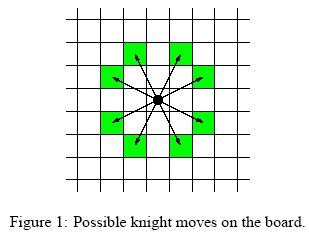POJ-1915 Knight Moves (BFS)
Posted GoesOn
tags:
篇首语:本文由小常识网(cha138.com)小编为大家整理,主要介绍了POJ-1915 Knight Moves (BFS)相关的知识,希望对你有一定的参考价值。
Knight Moves
| Time Limit: 1000MS | Memory Limit: 30000K | |
| Total Submissions: 26952 | Accepted: 12721 |
Description
Background
Mr Somurolov, fabulous chess-gamer indeed, asserts that no one else but him can move knights from one position to another so fast. Can you beat him?
The Problem
Your task is to write a program to calculate the minimum number of moves needed for a knight to reach one point from another, so that you have the chance to be faster than Somurolov.
For people not familiar with chess, the possible knight moves are shown in Figure 1.

Mr Somurolov, fabulous chess-gamer indeed, asserts that no one else but him can move knights from one position to another so fast. Can you beat him?
The Problem
Your task is to write a program to calculate the minimum number of moves needed for a knight to reach one point from another, so that you have the chance to be faster than Somurolov.
For people not familiar with chess, the possible knight moves are shown in Figure 1.

Input
The input begins with the number n of scenarios on a single line by itself.
Next follow n scenarios. Each scenario consists of three lines containing integer numbers. The first line specifies the length l of a side of the chess board (4 <= l <= 300). The entire board has size l * l. The second and third line contain pair of integers {0, ..., l-1}*{0, ..., l-1} specifying the starting and ending position of the knight on the board. The integers are separated by a single blank. You can assume that the positions are valid positions on the chess board of that scenario.
Next follow n scenarios. Each scenario consists of three lines containing integer numbers. The first line specifies the length l of a side of the chess board (4 <= l <= 300). The entire board has size l * l. The second and third line contain pair of integers {0, ..., l-1}*{0, ..., l-1} specifying the starting and ending position of the knight on the board. The integers are separated by a single blank. You can assume that the positions are valid positions on the chess board of that scenario.
Output
For each scenario of the input you have to calculate the minimal amount of knight moves which are necessary to move from the starting point to the ending point. If starting point and ending point are equal,distance is zero. The distance must be written on a single line.
Sample Input
3 8 0 0 7 0 100 0 0 30 50 10 1 1 1 1
Sample Output
5 28 0
Source
TUD Programming Contest 2001, Darmstadt, Germany
题目大意: 求马从一个点到另一个点需要的最少步数。
解题思路:经典的bfs求最短路径,利用优先队列(每次都是当前步数小的先出队),直接根据题目给的走路方法(dx[8]={-2,-2,-1,-1,1,1,2,2}; dy[8]={1,-1,2,-2,2,-2,1,-1};)进行bfs即可。(由于多组数据,每次bfs都要清空数据,也就是使队列为空)
#include<cstdio> #include<cstring> #include<queue> using namespace std; const int MAX=305; int l,sx,sy,ex,ey; int dx[8]={-2,-2,-1,-1,1,1,2,2}; int dy[8]={1,-1,2,-2,2,-2,1,-1}; bool vis[MAX][MAX]; struct Node { int x,y,step; bool operator < (const Node &a) const{ return a.step<step; } }; priority_queue<Node> q;//利用优先队列,每次出队的为步数较小的。 void bfs() { Node now,next; now.x=sx; now.y=sy; now.step=0; while(!q.empty()) //由于多组数据,每次bfs都要清空q { q.pop(); } q.push(now); while(!q.empty()) { now = q.top(); q.pop(); if(now.x==ex&&now.y==ey) //bfs结束,找到出口 { printf("%d\n",now.step); break; } for(int i=0;i<8;i++) { next.x = now.x+dx[i]; next.y = now.y+dy[i]; if(next.x>=0&&next.x<l &&next.y>=0&&next.y<l && !vis[next.x][next.y]) { vis[next.x][next.y]=true; next.step = now.step+1; q.push(next); } } } } int main() { int Case; scanf("%d",&Case); while(Case--) { memset(vis,false,sizeof(vis)); scanf("%d",&l); scanf("%d %d",&sx,&sy); scanf("%d %d",&ex,&ey); bfs(); //printf("bfs-end\n"); } }
以上是关于POJ-1915 Knight Moves (BFS)的主要内容,如果未能解决你的问题,请参考以下文章